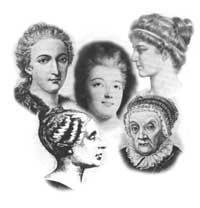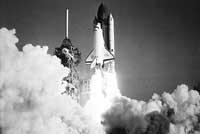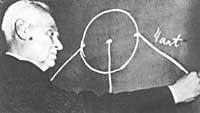DNA and Sputnik
2000/08/01 Kortabarria Olabarria, Beñardo - Elhuyar Zientzia Iturria: Elhuyar aldizkaria
In the review of this century that ends, regardless of Einstein's case, evidence of the events that have marked the decade has rarely been as clear as in the 1950s: Discovery of the DNA structure and launch of the artificial satellite Sputnik. The first served to know better the mystery of life and the other, in the following years, gained great strength when awakening the field. Perhaps the chip could also be interspersed, but this time the electronics is out.
American zoologist James Watson and British physicist Francis Crick saw nothing when in 1951 they met at the laboratories of the University of Cambridge in England. He only joined hobbies to unravel the mystery of life. Both believed that the day they discovered the structure of the DNA that houses the genetic material, they would also find the mechanism of transmission of genetic information. With that certainty they began to work. With the help of Maurice Wilkins' experiments and Rosalind Franklin's DNA X-rays, two years later they released the structure of DNA. It was then discovered that the DNA - a molecule of heresy - has a double-helix structure with the orders and planes necessary to create any living being.
For their discovery, Watson, Crick and Wilkins received nine years later, in 1962, the Nobel Prize. The chemist Rosalind Franklin did not receive any awards, as he has already passed away and the Nobel Prize is awarded to the survivors. The discovery strengthened molecular biology and became important for the advancement of biomedical sciences. Not only that, but the new theory of evolution, derived from which genes have gone from being part of the chromosome to being substances with biochemical information. Cloning, the human genome project, gene therapy, etc. are the result of the development of molecular biology. Therefore, discover and know the structure of DNA. It should be considered one of the most important achievements of 20th century science.
In addition to understanding the smallness of the inner molecules, the scientists at the time wanted to approach the grandeur of the universe. The competition between the United States and the Soviet Union – the cold war – was incandescent in all areas. This benefited scientists who wanted to investigate space, as the space race became the symbol of both countries. The first thing was very important. Thus, in early October 1957 the Soviet Union placed the first artificial satellite, Sputnik 1, in the orbit of the Earth. The frets of 58 centimeters in diameter and 83.6 kilos, contained inside devices measuring the density and temperature of the high atmosphere. The data collected in the space he sent to Earth. The orbit of the Sputnik satellite had a huge impact on the world, especially in the United States. After the launch of Sputnik, American politicians, scientists and military made every effort to match what was achieved by the Soviets, and perhaps for that reason, a year later, in 1958, NASA was created. Meanwhile, the Soviet Union sent the second satellite into space a month after the launch of Sputnik. The second, larger and more complex than the first, included inside a creature, the dog Laika. In the following months the space race shot up. It should be noted two facts: The probe of the Soviet Moon 3 allowed humans to see the hidden face of the Moon (1959). The Moon 2 probe reached the Moon. Thus, something sent by man came for the first time to another planet (1959). It seems that in the first steps of the space race were the Soviets.
The two facts mentioned may be the most important of the 1950s, but they were more than they:
- First kidney transplant in Chigaco, Richard H. Hand of surgeon Lawler (1950).
- Tergal, the type of polyester that soon triumphed in the making, was removed (1950).
- Danish Doctor Christian Hamburger operated for the first sexual change. George Jargens' New Yorker became Christine Jargens (1950).
- Magnetic tapes were used to store computer data. Test conducted in 1951 by the computer Univac 1, the first digital computer for commercial purposes.
- In Sweden Ruben Rausing and Erik Wallenberg opened Tetra Park with a new packaging system. Published a tetrahedron container capable of storing half a liter of milk (1951).
- Germanium, raw material for the manufacture of transistors, was replaced by silicon, which allowed to manufacture instruments of greater power (1951).
- First international television program. Coronation of Queen Elizabeth II (1953).
- Launch of the first pressurized pots of the SEB system. In Algorta they begin to be made under the name of SEB Magefesa (1953).
- Baron Bich took out the Bic pen in France (1953).
- The first nuclear power plant in the city of Obninsk was launched in the Soviet Union. There are currently 435 nuclear reactors in the world (1954).
- IBM announced the cessation of lamp-based computers and the use of transistors in all its products (1954).
- The Spanish Severo Ochoa managed to synthesize RNA, a molecule that makes possible the genetic transformation of DNA into proteins. At the age of four he received the Nobel Prize (1955).
- The first atomic submarine, the Nautilus (1955), was launched.
- Ampex presented the first video recorder. However, it was not marketed until ten years later (1956).
- The Boeing 707, the first jet aircraft for civilian flights, was introduced (1957).
- The first pacemaker was performed by American physician Clarence Walton. A year later the Swedish surgeon Ake Senning put him on a man (1957).
- The first chip was successfully tested in the laboratory. It was made by the American Jack St. Clair Kilby. It was large, but low capacity. The integrated circuits were the new step of the electronic revolution (1958).
- The Australian David Warren invented the black box for the planes (1958).
- Xerox photocopier (1959) was released.

Gai honi buruzko eduki gehiago
Elhuyarrek garatutako teknologia





